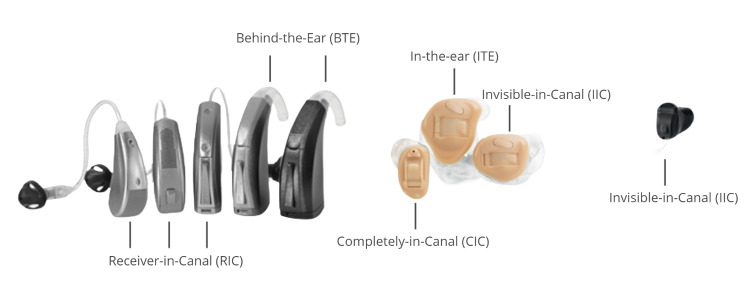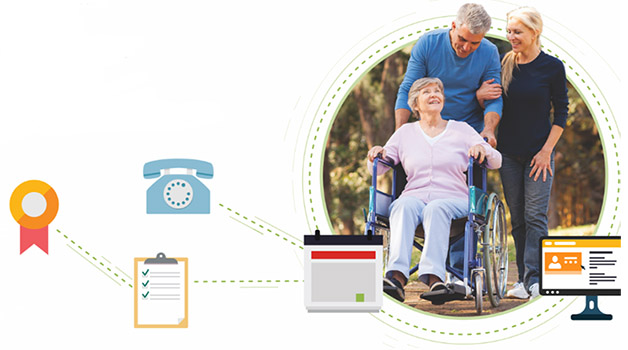10 Facts About Hearing Aids
History of the Hearing Aid
Hearing aids have evolved so much over time — it's hard to believe that a hollowed-out horn was the only option at one point! "Technology" didn't find itself in the hearing aid industry until the late 1800's with the telephone as inspiration. It wasn't until the late 1900's that the technology was able to fit into something that only fit on your ear versus a device with wires you had to clip on your pants.
Technology has been advancing so quickly since the end of the 20th century that the hearing aids of today are virtually invisible and have very few limitations on the levels of customization.
10 hearing aid facts that may surprise you
- Digital hearing aids can be programmed using your computer and can tailor the settings to your exact, unique needs. New digital technology allows you to take phone calls and hear the TV right through your devices on top of many other cool features.
- Hearing aids are more adjustable than ever. They can make the distinction between speech and background noise. When combined with special induction loops, hearing aids can accurately pick up announcements in crowded places and subtract the background noise and frequency distortions. These adjustable features are also available on your smartphone to a certain extent.
- Programming allows hearing aids to auto-adjust to memory based on your setting. This enables the hearing aid to automatically revert to your most comfortable setting. The settings are based on your previous use and real-time interactions with the environment.
- You have battery choices. Digital hearing aids are compatible with rechargeable technology. Disposable batteries can be used if needed.
- Two hearing aids are better than one, even if you’ve only lost your hearing in one ear. Remember sounds come from every direction. Two hearing aids increase your ability to detect which direction a sound is coming from, which can be lifesaving in certain situations, like crossing a busy street.
- Wearing hearing aids is different from putting on a pair of prescription glasses. Hearing aids don’t always work effectively right away. Usually, an audiologist won’t set your hearing aid to full prescription at the beginning, but rather they allow you time to adjust so you don’t feel overwhelmed. It can take up to three visits to get your hearing aids completely tuned in.
- Hearing aids take time to get used to. Your brain might not be used to distinguishing between which sounds are important and which aren’t. Just like trying to establish a new habit will take time, so does the habit of using your hearing aids.
- Tell your hearing provider you'd like to take the hearing aids for a test drive. The Union Plus Hearing program, in partnership with Amplifon, offers a 60-day, no-risk trial period with a 100% money-back guarantee if the hearing aids are not the right fit for you.
- Hearing aids can help reduce the symptoms of tinnitus, a condition generally experienced with noises or ringing in the ears or head. Some hearing aids provide a kind of ‘masking’ effect for tinnitus, allowing you to hear sounds more naturally.
- Hearing aids might slow down cognitive decline in the elderly. When you can’t hear properly, you are less engaged, and when you’re not engaged, there tends to be an increase in cognitive decline. It stands to reason that when hearing aids boost your confidence to take part in conversations and engage with people, they will help slow down mental decline.
If you have questions about the technology available today and what the best options are for you, schedule an appointment with a provider today.
At Union Plus we ensure our members are supported by providing the premier products, services and education that will help them maintain a high quality of life. Hearing loss is a degenerative condition and cannot be reversed, but it can be treated. If you or a member of your family have been experiencing any of these symptoms, schedule a comprehensive hearing exam today.


Hearing aids have evolved immensely. Modern hearing aids are virtually invisible and are almost limitless in customization. Here are 10 hearing aid facts you may not know.
AFT family gets protection for heart-stealing puppy
Brie is a mutt. Likely a mix of Golden Retriever and Australian Shepherd, she's a little over a year old, furry, playful, and very much loved.
"She's got a cream color like a dairy product," says Brie's owner, Bruce Kube, a hematology supervisor at a university hospital and a member of the American Federation of Teachers (AFT) Local 2190. "[The name] Cream wasn't good. Milk didn't apply, so we thought, Brie! Yeah, Brie!
Kube and his wife Carolyn, who is also a union member, adopted Brie in January 2022. “She licks our faces and climbs on top of us," Kube says. "Dogs are my life."
As seasoned dog owners, the Kubes knew that while puppies are cute, they can also be expensive. They decided to look into pet insurance through their unions and considered a few different options before settling on the Union Plus Pet Insurance plan, offered through Pets Best.
Pets Best offers union members up to 10 percent off monthly premiums1 and a choice of three types of plans with flexible coverage options, helping members get reimbursed up to 90% on their eligible vet bills.* There are no annual or lifetime limits and no networks – members can choose any licensed veterinarian, emergency vet, or specialist in the U.S. You can submit claims easily with the Pets Best mobile app or online customer account, and they even offer free direct deposit for claims reimbursements. Pets Best also offers free 24-hour access to veterinary experts via email, chat, or phone for everything from emergency care to behavioral advice.
"Pets Best had the best coverage of all the plans that we looked at," Kube says. "I'm happy with it. It's much better than paying [full price] for each visit." He adds, “We take advantage of the union benefits. My philosophy is it’s foolish to not get discounts when you can.”
To note: pre-existing conditions are not covered.
1 5% Group Discount plus 5% Weblink Discount applies to BestBenefit plans; Group Discount not available in AK, HI, or TN; Weblink Discount applies to first policy term only; not available in AK, FL, HI, or TN. Additional 5% discount applied if insuring more than one pet. Maximum allowable discount is 12%
*Select a plan that reimburses 70%, 80%, or 90% of the cost of eligible veterinary treatment. Limited to covered expenses.
Pet Insurance coverage offered and administered by Pets Best Insurance Services, LLC and underwritten by American Pet Insurance Company, a New York insurance company headquartered at 6100 4th Ave. S. Suite 200 Seattle, WA 98108. Please see www.americanpetinsurance.com to review all available pet health insurance products underwritten by APIC.

AFT member Bruce Kube's financial philosophy is simple, "It's foolish to not get discounts when you can!" He and his wife, Carolyn did just that when they got Union Plus Pet Insurance to protect their heart-stealing puppy, Brie. Read more about how the Kube's found that "Pets Best had the best coverage of all the plans that we looked at."


The warning signs of hearing loss
Along with noise-induced hearing loss, presbycusis (age-related hearing loss), can not only affect your overall quality of life, but can also contribute to serious health conditions such as diabetes, cardiovascular disease, depression and dementia.
As with any medical condition, hearing loss has recognizable symptoms. The most common symptom is tinnitus, defined as a constant ringing or humming in one or both ears. Other hearing loss symptoms include:
- Trouble understanding the difference between s and f, between p and t, or between sh and th in conversations (consonants)
- Difficulty understanding conversations in noisy places like a stadium or restaurant.
- Listening to the television or radio at high volumes in order to hear them.
- Requesting those you’re conversing with to speak more slowly and clearly.
- Muffled speech and other sounds.
- Difficulty hearing high-pitched sounds like doorbells, ringing telephones, alarm clocks, etc.
- Hypersensitivity to sounds (certain sounds are annoying or cause ear pain).
- Having trouble recognizing speech during phone conversations.
- Asking someone to speak louder or constantly asking someone to repeat what they said.
Hearing loss is a degenerative condition and cannot be reversed, but it can be treated. If you or a member of your family have been experiencing any of these symptoms, schedule a comprehensive hearing exam today.


Today approximately 48 million Americans suffer from some form of hearing loss.
Sore jaw? You may be grinding your teeth
Teeth grinding, also known as bruxism, is the clenching of the jaw and grinding of the teeth. Teeth grinding can cause teeth to become painful or loose, and sometimes parts of the teeth are literally ground away. Eventually, this can destroy the surrounding bone and gum tissue and lead to jaw problems.
For many people, teeth grinding is an unconscious habit. The most common causes are stress, anxiety, smoking, caffeine and sleeping disorders. So how can you stop grinding your teeth? It's best to consult your dentist to help development a treatment plan specialized for you. Night guards or a professionally made mouth guard can help prevent some grinding. By addressing and treating bruxism early, you can prevent extensive damage to your teeth.
Make sure you combine good at-home dental practices with routine checkups. If you don’t have a regular dentist or have been putting off a dental checkup, the Union Plus Dental Discount Plan can help you save on your next dental visit. Search for a participating dentist near you and schedule an appointment today!

*These plans are not insurance.

Do you often have a sore jaw and teeth — you could be suffering from teeth grinding.
Union Plus Hearing Program opens new doors for IL Ironworker
Hector Heredia has been an Iron Workers member for more than 40 years, most recently with Chicago's Local 63. These days, he makes sure all the automatic doors at Chicago O’Hare International Airport are running smoothly. Previously, he worked with power tools on steel structures.
"When I came up, there wasn't always hearing protection," he says. "Over time, I began losing my hearing."
Seven years ago, Heredia turned to hearing aids. His first set was okay, but he didn't like the warranty on them. A dedicated user of Union Plus programs, he discovered the Union Plus Hearing Care Program.
The Union Plus Hearing Program is free to access for union members and their families, which can even include the parents and grandparents of union members. Beneficiaries receive a free hearing exam and can get hearing aids and other treatments for more than 40% off, all offered through program partner Your Hearing Network.
"With my hearing loss in the mid- to severe zone, I need some really high-quality aids," says Heredia. "I have a top-of-the-line pair that is equipped with Bluetooth and Wi-Fi. My insurance couldn't compete with Union Plus. I loved my doctors."
Heredia has many friends from his local with hearing loss and has become a vocal advocate. "I recommend them to anyone I see who can’t hear me," he says. "Union Plus has made it easy for us as union members. I love all of their programs, but this one is especially helpful and personal." He adds, "I told my wife she had to get a pair. We’re both very pleased."


"With my hearing loss in the mid-to-severe zone, I need some really high-quality aids...[now] I have a top-of-the-line pair that is equipped with Bluetooth and Wi-Fi. My insurance couldn't compete with Union Plus.
AEA, SAG-AFTRA Member Shines Spotlight on Dental Discount Plan
Randy Redd, a writer and director based in Memphis, Tenn., has been a member of the Actors’ Equity Association (AEA) for 30 years and of SAG-AFTRA for nearly as long.
"I joined as an actor in ’90," Redd recalls. "It wasn’t until years and years later that I realized that the union is also affiliated with discount programs."
Redd was looking for a dentist a few years ago but felt discouraged by the expense of dental insurance. Instead, he turned to the Union Plus Dental Discount Plan, available through Careington.
"It seemed too good to be true at first," Redd describes. "But I saw a fantastic dentist who’s in the plan who just blew my mind. As a result of the discount plan, the cost is so low, and so affordable, for really first-rate care."
Through the Dental Discount Plan, union members, retirees, and their household family members can sign up and enjoy savings of 20% to 50% on dental care with one of the largest dental networks in the nation. Plans start at $7.95/month*.
"I had a great experience," Redd raves. "It’s really easy to find your way through Careington’s list of providers."
Redd recommends the Dental Discount Plan to other union members "all the time," he says.
He continues, "With Careington, I could get checkups and cleanings and regular care at the same level of care I’d been getting under any other plan. And the discounts are incredible. I had to get a root canal, and it’s incredible what I paid for that."
To learn more about the Union Plus Dental Discount Plan and other health savings options, visit unionplus.org/healthsavings.

*+$10 one-time, non-refundable enrollment fee
THIS PLAN IS NOT INSURANCE and is not intended to replace health insurance. This plan does not meet the minimum creditable coverage requirements under M.G.L. c.111M and 956 CMR 5.00. This plan is not a Qualified Health Plan under the Affordable Care Act. This is not a Medicare prescription drug plan. The range of discounts will vary depending on the type of provider and service. The plan does not pay providers directly. Plan members must pay for all services but will receive a discount from participating providers. The list of participating providers is at Union Plus Discount Dental Plan. A written list of participating providers is available upon request. You may cancel within the first 30 days after effective date or receipt of membership materials (whichever is later) and receive a full refund, less a nominal processing fee (nominal fee for MD residents is $5, AR and TN residents will be refunded processing fee). Discount Plan Organization and administrator: Careington International Corporation, 7400 Gaylord Parkway, Frisco, TX 75034; phone 800-441-0380.
This plan is not available in Vermont or Washington.

Union membership has been a constant in Randy Redd’s career, even as he’s changed paths and moved cities. The actor-turned-writer and director tapped into dental savings for union members through Union Plus a few years ago and has had nothing but good things to say about the Union Plus Dental Discount Plan ever since.

Becoming a Caregiver
Many people may find themselves becoming financial caregivers of a loved one as that loved one ages or experiences a life changing event. In this module, we will review what that relationship might look like, including a variety of legal structures to consider. We will cover financial accounts that may be involved, and provide next steps for those who are ready to move forward with the process of committing to a financial caregiver.
Ready to Learn More?
Watch our Becoming a Caregiver module. It's quick and easy. Simply click the yellow button at the bottom of this page. The module will start playing as soon as you arrive on the site. Once you've listened to the introduction, click the arrow to the right of the screen to move through the three different topics:
- Legal structures
- Roles and responsibilities
- How to plan ahead
Tips
Once you've started the module, you can see captions, adjust volume and pause the module by using the controls at the top right of the screen. You can also select the transcript button to see all of the content from the module.


Managing finances may be easier now than ever before. As people age, however, issues ranging from illnesses to lack of mobility can make it difficult for them to conduct their financial affairs. In these cases, seniors often choose to establish a relationship with someone they trust to act as their financial caregiver.
Save on Prescription Medications on a Limited Income or Without Insurance
There are several programs that are available to Medicare beneficiaries to help save money on your prescription drug costs. These include Extra Help and State Pharmaceutical Assistance Programs (SPAPs). There are also resources available for union members through Union Plus.
Extra Help
Extra Help is a federal program that helps pay for some to most of the out-of-pocket costs of Medicare prescription drug coverage. If your monthly income is up to $1,538 in 2018 ($2,078 for couples) and your assets are below specified limits, you may be eligible for Extra Help.
Even if your income or assets are above the eligibility limits, you could still qualify for Extra Help, because certain types of income assets may not be counted. If you are enrolled in Medicaid, Supplemental Security Income (SSI), or a Medicare Savings Program (MSP), you automatically qualify for Extra Help.
The Extra Help program pays for your Medicare Part D premium up to a state-specific benchmark amount. It also lowers the costs of your prescription drugs. People with Extra Help have a monthly Special Enrollment Period (SEP) to enroll in a Part D plan or switch between plans in 2018. In 2019, Extra Help gives you an SEP to enroll in or switch Part D plans once per quarter in the first three quarters of the year (January through March, April through June, and July through September).
Finally, Extra Help eliminates any Part D late enrollment penalty (LEP) you may have if you delayed Part D enrollment. Remember that Extra Help is not a replacement for Part D or a plan on its own: You must still have a Part D plan to receive Medicare prescription drug coverage and Extra Help assistance.
If you do not have Medicaid, SSI, or an MSP, you can apply for Extra Help program through the Social Security Administration using either the print or online application (If you have Medicaid, SSI, or an MSP, you should automatically be enrolled). Be sure to complete the entire application and provide accurate information so you receive all the benefits for which you qualify.
State Pharmaceutical Assistance Programs (SPAPs)
State Pharmaceutical Assistance Programs (SPAPs) are programs offered by many states that can help residents pay for prescription drugs. Each program works differently.
States may coordinate their drug assistance programs with Part D. Some SPAPs require that you sign up for Part D coverage in order to qualify for assistance. In these cases, if a prescription drug is covered by both your SPAP and your Part D plan, both the amount you pay for your prescriptions plus the amount the SPAP pays will count toward the out-of-pocket maximum you have to pay before reaching catastrophic coverage.
Many SPAPs continue providing coverage during your Part D plan’s coverage gap. Your SPAP may also help pay for your Part D plan’s premium, deductible and copayments.
Certain states have qualified SPAPs. Qualified SPAPs provide a Special Enrollment Period (SEP) to allow you to enroll in or make changes to your Part D or Medicare Advantage coverage. Contact your State Health Insurance Assistance Program (SHIP) to find out if your state has an SPAP, if you may be eligible, and how to apply. If you do not know how to contact your SHIP, call 877-839-2675 or visit www.shiptacenter.org.
Assistance for Union Members
If you do not qualify for Extra Help or an SPAP, but want to save money on prescription drugs, check out the instant savings you or your family can enjoy through Union Plus. There is no cost to download and use the savings card as a union member at thousands of participating pharmacies nationwide.
If you need help in finding a Part D Medicare plan or have any questions about health plans available to you, please contact the Union Plus Retiree Health Insurance Program. The program has Medicare Insurance advisors who can help you compare plans and costs available to you among thousand nationwide. Call 1-888-719-0689 (TTY 711) Monday - Friday from 8 am to 8 pm EST to speak with a licensed insurance representative trained in dealing with union members or visit unionplusmedicare.org for more information.
*Much of this content is from the Medicare Rights Center.

Prescriptions don't always have to be expensive. Union members can get instant discounts on many medications through the Union Plus Prescription Discount program. As a Medicare beneficiary you can save on your medications even if you have limited income or no insurance. If you need assistance with a Medicare plan, please contact the licensed insurance advisors for the Union Plus Retiree Health Insurance Program at 888-719-0689 or at www.unionplusmedicare.com.
10 Foods That Support a Healthy Mind
The golden years of our lives are not called golden for nothing, and while Robert Frost warns us that “nothing gold can stay,” studies have shown that we can, in fact, take certain steps to lengthen the duration of our golden years and keep our minds sharp. In fact, genetics account for only 20-30 percent of our aging process, while lifestyle accounts for 60-70 percent, with nutrition being the most influential factor. If we make smart choices, filling our plates with smart foods, we can keep our bodies and minds resplendent throughout our golden years.
Entrees: Fish and Turkey
Fatty fish, such as salmon, herring, mackerel and sardines, are some of the most potent proteins we can consume to help support healthy brain function. Chocked full of Omega-3 fatty acids, consuming fatty fish decreases the risk of Alzheimer’s Disease. People aged 65 and older who ate fish three or more times a week had a 26 percent decline in their risk of dementia. In addition, the consumption of these fish can decrease your risk of suffering a stroke. In fact, adding these fish to your diet can also help increase your memory as you age. Because fatty fish contain the mineral selenium, consuming them may help keep your mood balanced, as well. Diets low in selenium correlate with higher instances of depression, leading researchers to surmise that maintaining a higher level of the mineral can help support mental health.
If you’re not a fan of seafood, turkey is another adequate source of selenium, proven to help boost mood. While turkey’s tryptophan content has long been infamous for causing the all-too-familiar Thanksgiving Day food coma, tryptophan is actually quite misunderstood. Instead of making you tired all on its own, it produces serotonin, an anti-depressant that helps regulate your sleep cycles. Without tryptophan, the brain cannot produce serotonin, which helps with memory, transmitting impulses between nerves, sense of well-being and mood balance.
Sides: Broccoli and Beans
Both turkey and seafood pair well with broccoli, a superfood associated with a decreased risk of Alzheimer’s, as well as with helping to maintain “crystallized intelligence,” or the skills and knowledge you have acquired over and applied throughout the span of your life. Broccoli is also a good source of lutein, a plant pigment that embeds in cell membranes and protects your neurons. The consumption of lutein helps preserve our telomeres, essentially protective caps on both ends of our chromosomes that help safeguard the genome from degradation with age.
High in protein and low in saturated fat, beans make another smart food choice for brain health. They contain folate, iron, potassium, magnesium and choline (a B Vitamin), just to name a few nutrients. Consuming beans can increase acetylcholine, a neurotransmitter that assists with maintaining involuntary bodily function. Beans can also help stabilize glucose, which your brain needs but cannot store.
Garnishes: Berries, Walnuts and Avocado
Traditionally, we think of the major food groups as including carbohydrates and starches, fruits, vegetables, proteins, dairy and sweets. The MIND diet (Mediterranean-DASH Diet Intervention for Neurodegenerative Delay) lists berries as their own, standalone food group, though fruit is not included as its own category. In a recent study, the motor skills and learning of older rats who consumed blueberry extract improved to match the ability of much younger rats, implying that people who consume blueberries may be able to reverse cognitive decline resulting from age. Berries contain anthocyanin, a phytochemical that reduces damage from free radicals, radiation and inflammation, thus also helping reduce your chances of Alzheimer’s by protecting the brain from “oxidative stress.” In addition, like broccoli, berries provide antioxidants that preserve telomeres.
Walnuts provide omega-3 fatty acids, polyunsaturated fats that are good for your heart. They also provide omega-6, Vitamin E, folate, Vitamin B6 and magnesium, all found to boost mood and decrease memory loss.
Like berries, avocados can help decrease your chance of Alzheimer’s. They contain monounsaturated fat, which lowers the bad cholesterol linked to the development of Alzheimer’s, and increases blood flow to the brain. In addition, consuming avocados helps lower blood pressure, and so also decreases risk of hypertension, a condition that often contributes to cognitive decay. In fact, lower blood pressure supports overall brain health.
Drinks: Milk and Lemonade/Fruit Juice
Milk provides Vitamin D, low levels of which are associated with depression, and Vitamin B12, a lack of which causes low levels of S-adenosylmethionine, used in the brain to process chemicals that balance mood. Milk also provides thiamine, which the body cannot produce on its own. A thiamine deficiency can cause Korsakoff’s syndrome, a condition that affects memory and balance, and can cause ataxia (lack of muscle coordination), and other symptoms.
While we’re often warned against indulging in too many sugary drinks, an occasional lemonade or fruit juice can provide us with a natural form of glucose that helps the body process sugar from carbs, and temporarily boosts memory, alertness and mental ability.
Dessert: Chocolate
If you’ve ever needed a reason to justify eating more chocolate, here it is: The Vitamin E found in dark chocolate decreases cognitive decline with age. In addition, dark chocolate contains caffeine, which improves focus and stimulates endorphin production, thus kick-starting a sense of well-being and a feeling of happiness. Along with Vitamin E and caffeine, consuming dark chocolate provides you with flavanol, an antioxidant that increases blood flow to brain.
The Smart Plate: A Meal to Power your Brain
After all this talk of food, your stomach might be growling. Here’s how you can create your own smart plate for dinner tonight. First, include a fist-sized portion of fatty fish or turkey garnished with one-quarter avocado, sliced thinly. According to Carol Sorgen’s article, “Eat Smart for a Healthier Brain,” available on WebMD, because avocados contain high levels of fat, experts recommend eating only one quarter to one half of an avocado daily. As a side, include a small portion of broccoli garnished with chopped walnuts. You can also add nuts to cereal, yogurt, desserts, and meats. The experts in Sorgen’s article recommend consuming one ounce per day. They also recommend eating half a cup of beans daily, so go ahead and add a scoop to your plate, right beside your broccoli. For dessert, enjoy half an ounce to one ounce of dark chocolate (the daily recommendation), shaved over a quarter cup of blueberries. Sorgen’s nutritionists recommend consuming one cup of fresh, frozen or freeze-dried berries a day. Oh, and don’t forget to wash it all down with a tall glass of milk!
This article is brought to you by The Hartford, provider of the Union Plus Life Insurance plans.
Group coverage is available for your family in the event of the unexpected. Learn more about valuable Life insurance benefits and union rates here.

The Hartford® is The Hartford Financial Services Group, Inc., and its subsidiaries, including issuing company Hartford Life and Accident Insurance Company. Life Insurance is underwritten by Hartford Life and Accident Insurance Company, Hartford, CT 06155.
All benefits are subject to the terms and conditions of the policy. Policies underwritten by Hartford Life and Accident Insurance Company detail exclusions, limitations, and terms under which the policies may be continued in force or discontinued. Life Form Series includes GBD-1000, GBD-1100, or state equivalent.
Your diet is an important part of your brain health, keep your mind sharp with these 10 foods.
It Looks Like You Have a Cavity
Cavities are likely to form the more sugar we snack on. Our mouths are full of bacteria, some helpful, some malevolent, and the latter bacteria feeds on sugars, forming acid that eats away at our teeth. Like your dentist always reminds you, daily brushing (with a toothpaste that has fluoride in it) and flossing can help prevent the buildup of sugar and cavities.
In the earliest stages of a cavity, it’s entirely likely that you’ll feel nothing, as the first layer of your teeth is simply enamel, which has no nerves and thus no sensitivity. The good news is that this stage of a cavity can be reversed. Proper oral hygiene can repair the enamel, stopping that pesky cavity in its tracks.
Unfortunately, some cavities persevere, which leads to more pronounced symptoms. The classic one is, of course, a toothache, especially when you eat something sweet. Remember how the bad bacteria feeds on sugar? Well, coating an already decaying tooth in more sugar produces more acid, which will eventually dissolve all the enamel and make its way to your tooth’s sensitive nerve endings, causing discomfort.
This expanding cavity can also lead to other symptoms, such as a bad taste in your mouth or bad breath that just won’t go away. It’s possible to feel or even see a more advanced cavity – you may notice a dark spot on your tooth, or a mysterious hole. Any of these indications are cause to see a dentists as soon as possible.
Whatever stage a cavity is in, it’s certainly a nuisance, especially once your dentist hands you your bill. The Union Plus Dental Discount Plan can help you save on your next dental visit.
Plus, use code UPGC10* when you sign up for any annual Dental Discount Plan and we’ll send you a $10 Starbucks gift card!
Search for a participating dentist near you and schedule an appointment today!

*You must purchase an annual plan and be a member of the Union Plus Dental Discount Plan for 30 days in order to receive the gift card.
It’s the phrase every patient reclining in the dentist’s chair dreads. Was there something you could have done to prevent this?